10 Facts About Ruth's Chris Steak House's Famous Ribeye Steak
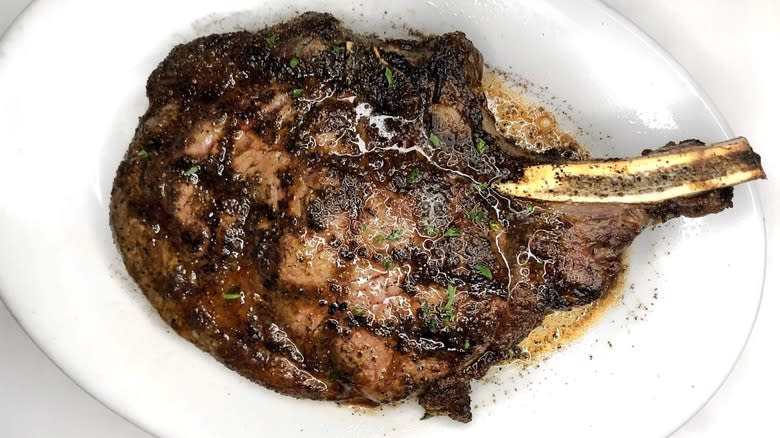
It's no secret that Americans love their steak. While cuts of all descriptions have their fans, America's favorite is thought to be the ribeye. In a survey conducted by Meats by Linz and published by Fox News, 61% of respondents named ribeye as their favorite. Filet mignon, the second most popular cut, was named by 47% of respondents.
Ribeyes are cut from either side of the cow's spine, an area that does not move much during the animal's life. As a result, the meat here is incredibly tender. A high proportion of intramuscular fat -- otherwise known as marbling -- is also prevalent in this area, ensuring ribeyes are particularly flavorful.
While Americans are spoiled for choice when it comes to choosing a steakhouse, few are as prevalent or popular as Ruth's Chris Steak House. This international chain has developed a reputation for serving consistently excellent steaks that are sizzling, full of flavor, and expertly cooked. Unsurprisingly, Ruth's Chris is known for serving several exceptional ribeyes. Here's how one of America's favorite steakhouses sources, prepares, and serves America's favorite steak.
Read more: The 13 Best Steaks For Grilling
The Ribeye Steaks Are Cut From USDA Prime Or High Choice Beef
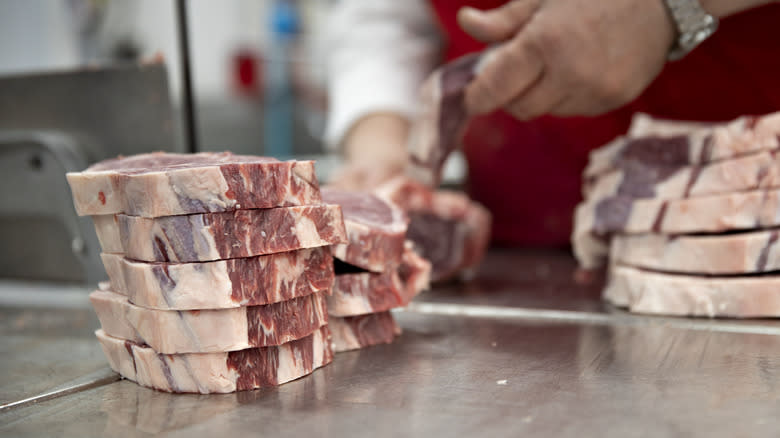
There's no two ways about it: high-quality beef is a must when cooking and serving steaks. Ruth's Chris Steak House has taken this lesson to heart and only serves ribeye steaks that are cut from USDA Prime or high cuts of Choice beef.
USDA Prime is the highest categorization of beef in the United States. To be defined as Prime, steaks must come from young cattle and display a great deal of marbling. Only 3% of all beef graded in America is categorized as Prime. By comparison, Choice beef makes up 50% of all beef that's graded in America. While similar to Prime, Choice demonstrates less marbling.
Many branches of Ruth's Chris Steak House only serve USDA Prime. Those that do serve Choice beef specify that they only serve high Choice. This is meat that is very close to being defined as Prime. Some industry experts even prefer high Choice to Prime.
Both USDA Prime and high Choice beef make excellent ribeyes. The abundance of intramuscular fat present in both categorizations softens during the chain's unique cooking process, making the ribeyes at Ruth's Chris extremely tender.
Cattle Are Grass-Fed And Finished On Grain
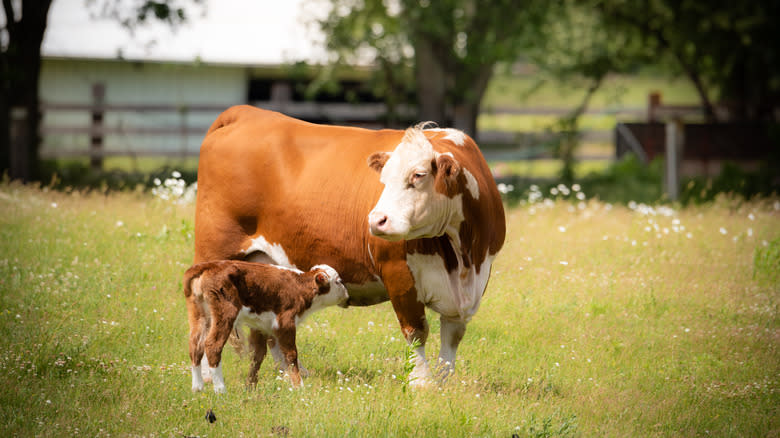
Marbling is not the only thing that affects a steak's flavor. How the cow was reared, especially its diet, also has a large impact. For example, meat from exclusively grass-fed cows is known to contain less marbling. As a result, grass-fed beef often demonstrates a gamier flavor dominated by minerality. In contrast, grain-fed beef is fattier, more flavorful, and sweeter.
The cows butchered for Ruth's Chris ribeyes are initially fed on grass before being finished on corn. This approach is the best of both worlds; cows get to spend time on pasture enjoying a natural grass diet, while the short, grain-fed finishing period ensures the meat is as marbled and flavorful as possible. Aside from flavor, this approach ensures that there is enough marbling to make sure that the ribeye does not dry out during cooking. Otherwise, the meat would be at risk of becoming tough and unpleasant to eat.
Like Every Steak At Ruth's Chris Steak House, The Ribeye Is Wet Aged
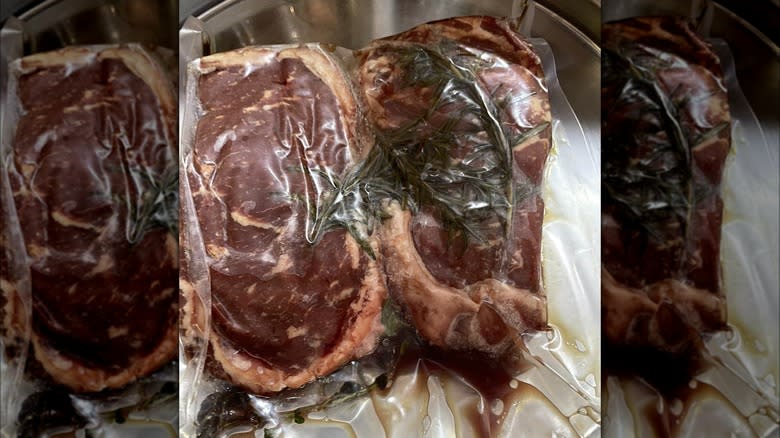
It is customary for steak to be aged before it is cooked and served to the public. Traditionally, all steak was dry-aged. This process involves hanging cuts of meat in temperature-controlled environments. During dry aging, the steaks lose water and have tissues broken down by a variety of enzymes and fungi. This gives dry-aged steaks a complex, funky flavor similar to blue cheese.
Ruth's Chris Steak House uses an alternative aging method: wet aging. During this process, the meat is sealed tightly in vacuum-packed bags. Wet aging comes with a few advantages. Firstly, it's more consistent, whereas dry aging is never a completely replicable process. Secondly, wet aging results in less waste: water is not lost, and the outer layer of meat does not have to be trimmed away.
Wet aging does have its drawbacks. As the ribeye ages in its own blood and not in contact with the air, a gamier flavor develops that can sometimes mask the quality of the meat. As a result, many steak aficionados will only eat dry-aged steak. Interestingly, studies have shown that the average American consumer prefers wet-aged steaks to dry-aged steaks. In other words, Ruth's Chris Steak House is giving the people what they want.
Ribeyes Are Broiled At 1800 Degrees Fahrenheit
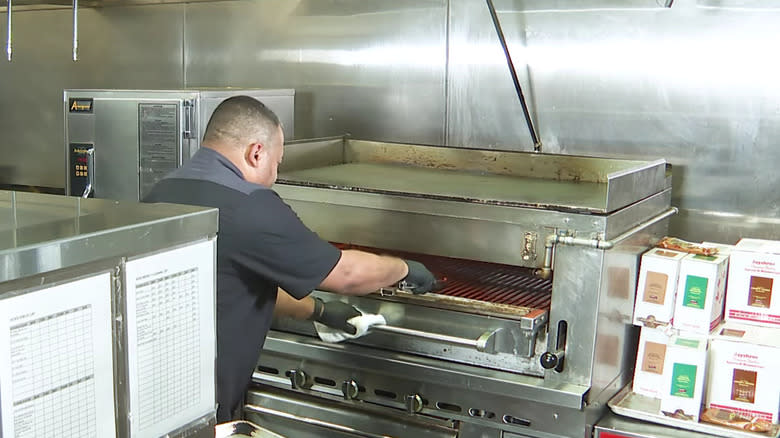
Aside from aging, a steak's flavor and texture are influenced by its cooking. At Ruth's Chris Steak House, the ribeyes, like all other steaks, are broiled at 1800 degrees Fahrenheit. This method crisps the outside of the steak better and faster than grilling does. The result is a well-charred steak that has a juicy, perfectly cooked interior.
Ruth's Chris Steak House's founder Ruth Fertel -- who had a college degree in chemistry and physics -- designed the broiler herself. The broiler she designed is an infrared broiler that cooks steak via radiant heat. This method results in even heat being applied to the entirety of the ribeye, ensuring the steaks are evenly cooked. What's more, this method causes less evaporation than a conventional grill or broiler, another reason why Ruth's Chris' ribeyes are so juicy.
Most conventional broilers have a maximum temperature of approximately 550 degrees Fahrenheit. This means Ruth's Chris Steak House's cooking style is almost impossible to replicate at home unless a specialist infrared broiler is bought for home use. Due to the broilers' high price points, most people will only be able to enjoy these high-temperature steaks at a Ruth's Chris restaurant.
The Ribeye Is Served On Plates Heated To 500 Degrees
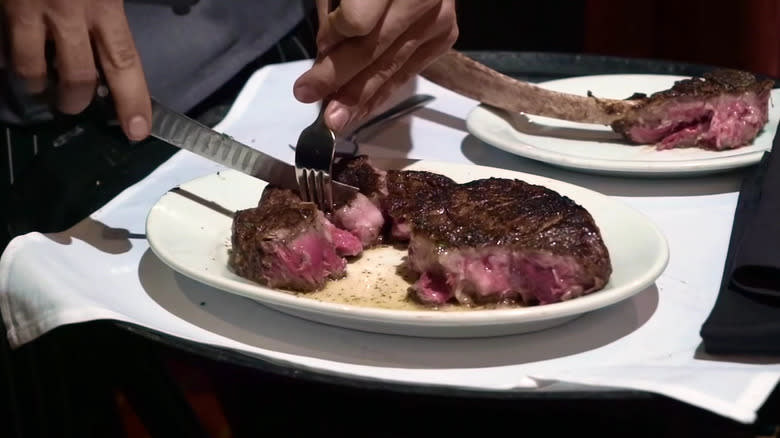
As well as cooking them in an 1800 degrees Fahrenheit broiler, Ruth's Chris Steak House also serves every single ribeye on a plate heated to 500 degrees Fahrenheit. The reason behind this was explained to Dine Magazine by Lana Duke, an advertiser for Ruth's Chris Steak House: "Her [Ruth Fertel's] goal was to get the finest beef that money could buy, and she wanted the last bite to be as hot as the first. The sizzle in the plate kept it hot to the very last bite."
Duke also mentioned the marketing aspect of Ruth's Chris' iconic piping hot plates. The sizzle they created became associated with Ruth's Chris. Today, this sizzle is a large part of the brand's identity. This is exemplified by several online forums that have threads dedicated to discussing the Ruth's Chris Steak House experience. All mention the sizzle and how pre-heated plates are needed to achieve it.
Ruth's Chris Steak House Recommends Pairing The Ribeye With Robust Red Wines

As a heavily marbled steak, Ruth's Chris Steak House's ribeye is immensely flavorful. While making it a joy to eat, its intensity does make drink pairings difficult to get right. The general consensus is that ribeyes require bold, robust wines that can stand up to the flavor; Ruth's Chris recommends young cabernet sauvignons as well as zinfandel.
This recommendation was backed up by chef Bernhard Klotz, who told Forbes: "A classic wine and steak pairing is a ribeye with a Cabernet Sauvignon as the high tannins present in the wine help cut through the juiciness of the steak. A spicy Zinfandel is another great choice as the fruitiness of the wine contrasts well with the robust meatiness of the ribeye."
While more difficult to match, white wine and ribeye can work. White Riojas are often seen as a good choice, as are spicy white wines made from marsanne grapes. Of course, these niche wines are not often stocked by Ruth's Chris Steak House, although several branches of the chain allow guests to bring their own wine when they dine at the restaurant.
The Chain Serves Both Bone-In And Boneless Ribeye
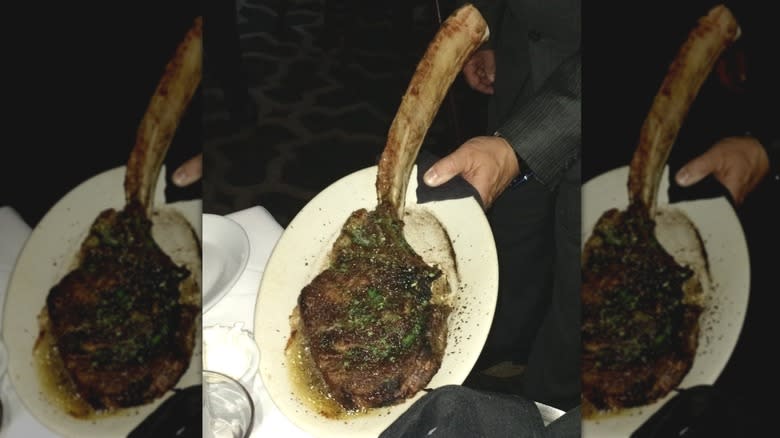
The ribeye is such a popular cut of meat that some Ruth's Chris Steak House restaurants serve three different versions of it: a 16-ounce boneless ribeye, a 22-ounce bone-in cowboy ribeye, and a 40-ounce bone-in tomahawk ribeye. While all of these ribeyes are excellent, each has unique characteristics.
Boneless ribeyes are often preferred because they are easier to eat than bone-in cuts. Furthermore, the belief that bone-in steaks have more flavor has been repeatedly debunked. That being said, bones do result in the surrounding meat staying up to 10 degrees Fahrenheit colder than other parts of the steak. This creates textural contrast across the steak, which some diners enjoy.
Bone-in ribeyes also lose slightly less moisture than their boneless counterparts, making them even juicier. Finally, there is the visual appeal. Tomahawk ribeyes are particularly eye-catching given the presence of their eponymous bone; this can make a ribeye at Ruth's Chris feel like a real treat.
The Steak Arrives At The Table Topped With Butter
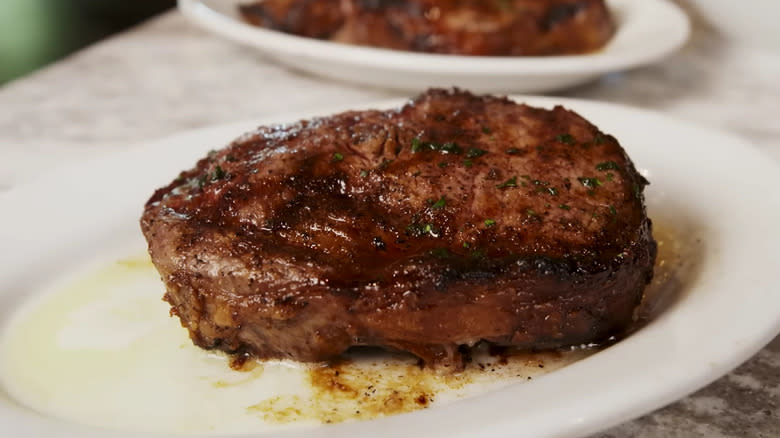
All Ruth's Chris Steak House's steaks arrive at the table topped with butter. This is nothing new, in fact, it was Ruth Fertel herself that insisted all steaks were topped with butter. The reason for her decision was simple: Fertel wanted all her dishes to have maximum flavor. This is not a novel idea; adding butter during or after the cooking process is a favorite trick of many world-class chefs.
One ex-employee stated on Quora that this was for impact as well as flavor: "Their little trick is they put clarified butter on the steak as it is leaving the kitchen. The plate is scorching hot because they keep them in the oven and the room temperature butter hits the plate and sizzles for effect."
Not all diners enjoy so much butter on their steak. Several customers of Ruth's Chris Steak House have even described the smell and flavor of so much butter as overwhelming.
Like All Of The Brand's Steaks, The Ribeye Is Never Frozen
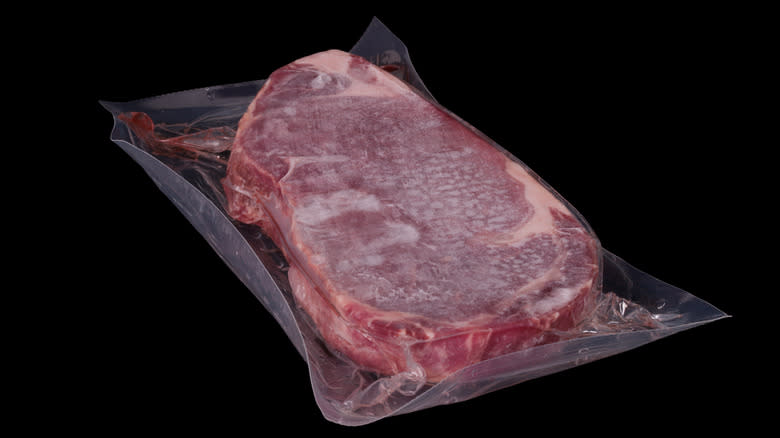
The menu at Ruth's Chris Steak House specifies that the steaks are never frozen. This is interesting, given that freezing steaks does not impact flavor or texture if done correctly.
It is likely that Ruth's Chris refuses to freeze its steaks due to long-held negative perceptions that surround frozen steak. These perceptions are not without some warrant; steaks that are not wrapped properly before freezing can suffer from oxidation and dehydration, which diminish the quality of the steak. Those that are frozen too slowly also develop ice crystals that ruin the texture of the meat.
If it wanted, Ruth's Chris could probably implement a freezing procedure that has minimal impact on the meat. But, by not freezing steaks like ribeye at all, Ruth's Chris avoids the possibility that any steaks will be negatively impacted. This is a sensible choice that reflects the brand's dedication to serving the best steaks.
Ruth's Chris Steak House Seasons Ribeyes Simply
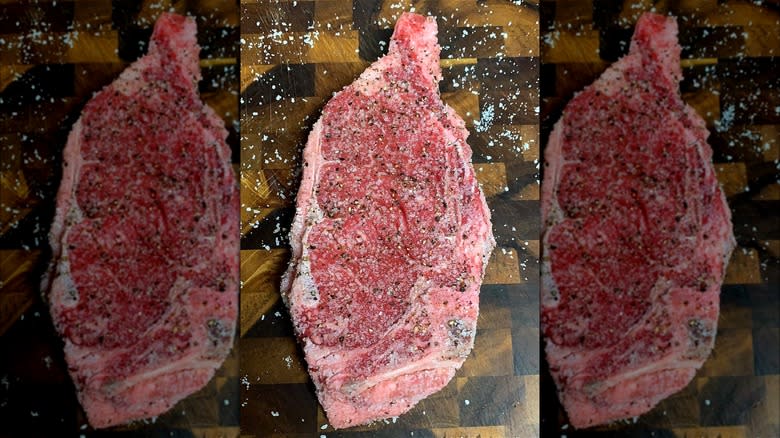
Ruth's Chris Steak House is known for restraint when it comes to seasoning its steaks. Unless otherwise specified, the ribeyes are only seasoned with salt and pepper. After cooking, they are topped with butter and chopped parsley. The brand does not believe in marinating its steaks and this is apparent in the eating; the ribeye's flavor stands front and center.
This simple approach does not mean there is a lack of attention to detail. On the contrary, Ruth's Chris even takes the grain size of certain salts into account when preparing steaks. The chain opts for the larger-grained kosher salt thanks to its ability to form a better crust on the meat. This decision is backed up by tests done by America's Test Kitchen, which proved kosher salt developed a good crust.
Those who want to add further flavors to their steak can embellish their ribeye with a bleu cheese crust or au poivre sauce. However, we would suggest this exceptional cut of meat requires neither.
Read the original article on Daily Meal.

